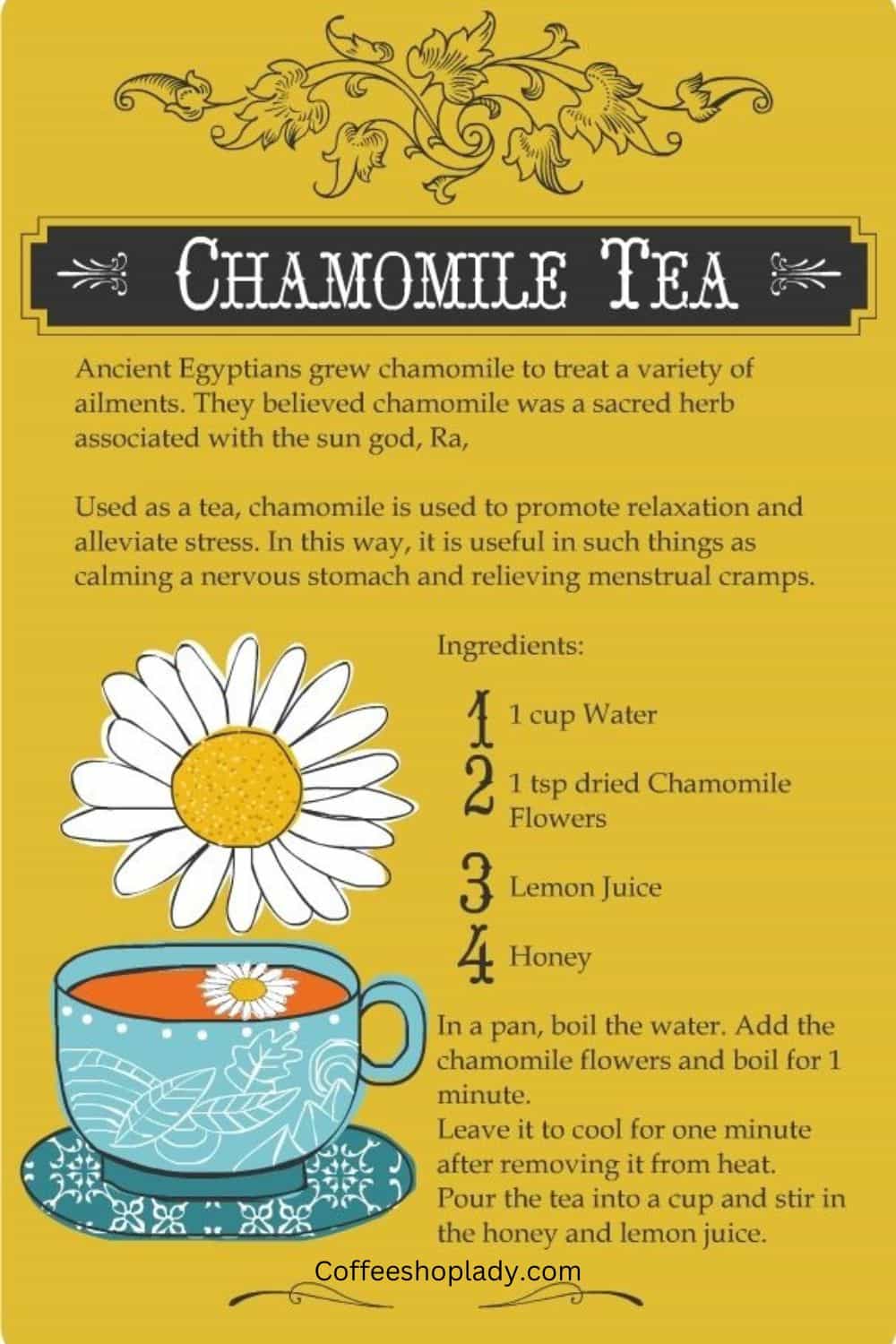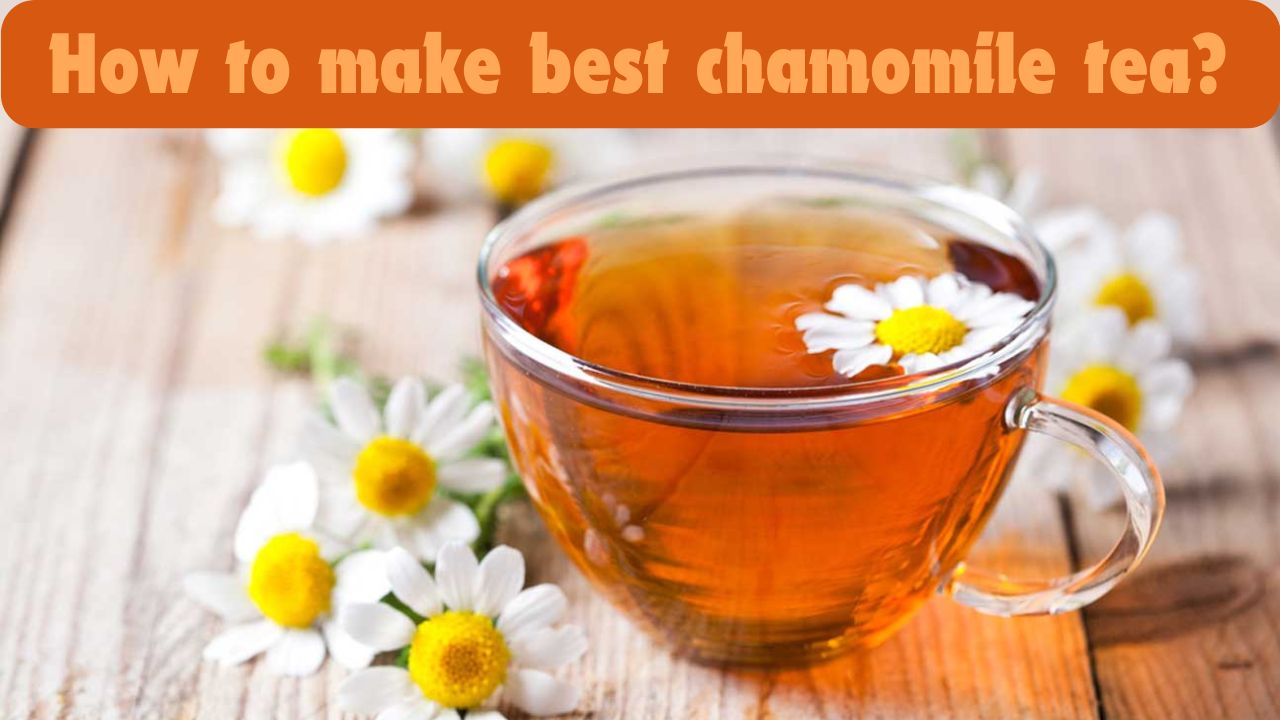Written By: Sherry Harris
Chamomile tea has been cherished for centuries as a natural remedy for relaxation and overall well-being. This article delves into the benefits, ingredients, and preparation methods of this soothing herbal tea. Whether you’re a tea enthusiast or someone looking for a natural way to unwind, this guide will provide everything you need to know about chamomile tea. From its calming effects to the perfect recipe, we’ll cover it all step by step.
Table of Contents
How to make best chamomile tea?
What is Chamomile Tea?
Chamomile tea is a herbal infusion made from the dried flowers of the chamomile plant, known for its mild, floral aroma and taste. Unlike black or green tea, it’s naturally caffeine-free, making it a popular choice for relaxation and stress relief. It’s been used in traditional medicine for its calming effects, aiding sleep, and improving digestion.
The tea is primarily made from two varieties of chamomile: German chamomile (Matricaria chamomilla) and Roman chamomile (Chamaemelum nobile). While both offer similar benefits, German chamomile is the more commonly used variety for tea. Its antioxidants, especially apigenin, contribute to its many health benefits, including reducing inflammation and promoting restful sleep.
Does Chamomile Tea Have Caffeine?
No, chamomile tea is entirely caffeine-free, making it an ideal choice for individuals looking to avoid stimulants. Unlike black or green tea, which are derived from the caffeinated leaves of the Camellia sinensis plant, chamomile tea is an herbal infusion made from chamomile flowers. This natural absence of caffeine allows it to be consumed at any time of the day without the risk of disrupting sleep or causing jitters.
Its caffeine-free nature makes chamomile tea a popular bedtime drink. It’s especially beneficial for those who want to relax, improve sleep quality, or unwind after a long day. Whether you’re sensitive to caffeine or simply looking for a calming alternative, chamomile tea is a soothing and safe choice for everyone.
Choosing the Best Chamomile
Fresh vs. Dried Chamomile
Dried chamomile flowers are convenient and more concentrated in flavor, making them ideal for regular tea-making. Fresh chamomile, while aromatic and vibrant, can be harder to find and has a shorter shelf life. Choosing the right type depends on your preference and availability.
Organic Chamomile
Using organic chamomile ensures your tea is free from harmful pesticides and chemicals. This choice supports your health and provides a cleaner, purer tea experience.
How to make best chamomile tea?
Essential Tools
To make chamomile tea, you’ll need a tea infuser or strainer for loose flowers, a kettle for heating water, and your favorite mug to serve. These tools ensure a seamless tea-making process.
Key Ingredients
- Dried Chamomile Flowers: The main ingredient, these flowers provide the tea’s signature floral aroma and calming effects.
- Water: Filtered water enhances the tea’s natural flavors and ensures a clean, crisp taste.
- Honey or Sugar (Optional): Sweeteners like honey balance the mild bitterness of chamomile tea and add a touch of sweetness.
- Lemon Slices (Optional): Lemon can give your tea a citrusy kick, enhancing its refreshing quality.
- Mint Leaves (Optional): Adding mint leaves complements the floral notes with a cool and invigorating twist.
- Cinnamon or Spices (Optional): A dash of cinnamon adds warmth, while spices like cardamom provide complexity.
These ingredients can be tailored to your preferences, making your chamomile tea experience both versatile and enjoyable.
Step-by-Step Guide
Preparing Ingredients: Measure 1–2 teaspoons of dried chamomile flowers for every cup of tea. If you prefer fresh chamomile, double the quantity to enhance the flavor.
Boiling Water: Heat water to just below boiling, around 200°F. Boiling water can scald the delicate chamomile flowers, ruining their flavor.
Steeping Flowers: Pour the hot water over your chamomile flowers and let them steep for 5–7 minutes. This timeframe balances the flavor and ensures the chamomile tea is neither too weak nor too strong.
Adding Sweeteners: Sweeten your tea with honey, which complements the floral notes of chamomile. You can also add a slice of lemon for a citrusy twist or a sprig of mint for added freshness.

How to make best chamomile tea?
Variants of Chamomile Tea
Chamomile tea comes in various variants, each offering unique flavors and benefits. Let’s explore the most popular ones: How to make best chamomile tea?
German Chamomile
German chamomile tea is the most commonly consumed variety worldwide. Made from the flowers of Matricaria chamomilla, this tea is known for its smooth, floral flavor and calming properties. It’s rich in antioxidants like apigenin, which promote relaxation and reduce inflammation. This variant is often used to soothe digestive issues and improve sleep quality.
Roman Chamomile
Roman chamomile tea is derived from Chamaemelum nobile and is slightly more bitter compared to its German counterpart. It’s highly aromatic and often used in aromatherapy and teas for relaxation. This variant is excellent for reducing stress and calming the nerves, making it a great bedtime choice. Its subtle differences in taste make it a favorite among those who enjoy herbal infusions.
Blended Chamomile
Blended chamomile teas combine chamomile with other herbs like mint, lavender, or lemongrass. These blends enhance the flavor profile while adding complementary health benefits. For example, chamomile and lavender promote relaxation, while chamomile and mint aid digestion. These versatile combinations cater to different preferences and health needs.
Chamomile Flower
This variant uses whole dried chamomile flowers, providing a more potent aroma and flavor. It’s ideal for tea enthusiasts seeking a more authentic chamomile experience. Whole flower tea is often richer in beneficial compounds, offering enhanced relaxation and anti-inflammatory effects compared to processed versions.
Alternatives to Chamomile Tea
If chamomile tea isn’t your cup of tea, there are several alternatives that offer similar relaxation benefits or unique health advantages. Let’s explore some popular choices:
Peppermint Tea
Peppermint tea is a caffeine-free herbal tea known for its cooling and refreshing taste. Made from peppermint leaves, it’s often used to soothe digestive issues and reduce headaches. Its natural menthol content provides a calming effect, making it a great alternative to chamomile tea for relaxation and stress relief. Additionally, peppermint tea is a wonderful choice after meals to aid digestion.
Lavender Tea
Lavender tea offers a floral aroma and calming properties similar to chamomile. This herbal tea is often associated with promoting better sleep and reducing anxiety. Its naturally caffeine-free nature makes it a perfect bedtime drink. Lavender’s subtle sweetness and relaxing effects provide a soothing alternative to chamomile tea, especially for those who prefer floral flavors.
Rooibos Tea
Rooibos tea, also known as red tea, is a caffeine-free option with a naturally sweet and earthy flavor. Native to South Africa, it’s packed with antioxidants and is known for its anti-inflammatory properties. Rooibos tea supports heart health and promotes relaxation, making it a great alternative to chamomile tea. Its versatility also allows it to be enjoyed hot or iced.
Lemon Balm Tea
Lemon balm tea is another caffeine-free herbal infusion, offering a mild citrus flavor. It’s known for reducing stress, improving sleep, and supporting cognitive function. This tea is an excellent alternative to chamomile tea, particularly for individuals seeking a more citrusy profile. Lemon balm’s calming effects make it a favorite among those dealing with anxiety or insomnia.
Green Tea
For those looking for a mild caffeine boost, green tea is a great option. Known for its antioxidant-rich profile, green tea supports metabolism, heart health, and mental focus. Although it contains caffeine, it’s much lower than coffee, making it a balanced choice for a gentle energy lift. Green tea can serve as an invigorating alternative to chamomile tea for daytime use.
| Alternative | Caffeine Content |
|---|---|
| Peppermint Tea | Caffeine-Free |
| Lavender Tea | Caffeine-Free |
| Rooibos Tea | Caffeine-Free |
| Lemon Balm Tea | Caffeine-Free |
| Green Tea | Low Caffeine (20–50 mg/cup) |
Each of these alternatives offers unique flavors and benefits, catering to a wide range of preferences while providing calming or energizing effects.
Do You Know?
👉 Does Tazo Chai Tea Have Caffeine?
👉 Does Arizona Green Tea Have Caffeine?
Tips for Perfect Chamomile Tea
- Steep the tea for just the right amount of time—5 to 7 minutes—to prevent bitterness.
- Use filtered water to enhance the tea’s flavor and ensure a clean-tasting chamomile tea.
- Experiment with sweeteners like honey or stevia to find your perfect balance.
Common Mistakes to Avoid
- Over-steeping your chamomile tea can lead to a bitter taste.
- Avoid boiling water, as it can scald the chamomile flowers and reduce their delicate flavor.
- Using poor-quality or unfiltered water can impact the taste of your chamomile tea.
Health Impact of Chamomile Tea
Benefits: Chamomile tea offers numerous benefits, making it a popular herbal remedy. It is known for its calming effects, helping to reduce stress, anxiety, and insomnia. Rich in antioxidants like apigenin, it supports heart health, boosts immunity, and helps fight inflammation. Additionally, it aids digestion, soothes menstrual cramps, and may help regulate blood sugar levels, making it a versatile addition to a healthy lifestyle.
Potential Side Effects: Despite its benefits, chamomile tea can have potential side effects for some individuals. Those allergic to plants in the daisy family, such as ragweed, may experience allergic reactions. Overconsumption might lead to nausea or dizziness in sensitive individuals. Chamomile can also interact with certain medications, such as blood thinners or sedatives, so it’s essential to consult a doctor before regular use if on medication.
Daily Intake of Chamomile Tea
Drinking 1–2 cups of chamomile tea daily is considered safe and beneficial for most people. For those seeking relaxation or improved sleep, a warm cup before bedtime can work wonders. Since chamomile tea is caffeine-free, it’s gentle on the body and suitable for any time consumption.
However, excessive consumption—more than 4 cups daily—might lead to mild side effects, especially for those with allergies to daisies or certain plants. If you’re new to chamomile tea, start with smaller amounts to see how your body responds. As with any herbal remedy, consult a healthcare provider if you have underlying health conditions.
Conclusion
Chamomile tea is a timeless herbal remedy that offers a myriad of health benefits. From promoting better sleep to aiding digestion, it’s a versatile beverage that fits seamlessly into any wellness routine. Whether you prefer it plain or enhanced with honey and lemon, its soothing properties remain constant.
By understanding the ingredients, preparation methods, and recommended intake, you can make the most of this calming beverage. Whether it’s to unwind after a long day or as part of a daily ritual, chamomile tea can be a simple yet powerful addition to your lifestyle.
Frequently Asked Question
Q. Can Chamomile Tea Help with Sleep?
Yes, chamomile tea is widely known for its ability to promote better sleep. Its natural compound apigenin binds to receptors in the brain, inducing relaxation and reducing insomnia. Drinking a warm cup of chamomile tea before bed can create a calming bedtime ritual. Its caffeine-free nature makes it a safe choice for improving sleep quality without the risk of restlessness.
Q. Is Chamomile Tea Safe for Pregnant Women?
Pregnant women can consume chamomile tea in moderation, but caution is advised. While it can help with stress and digestion, high amounts may stimulate uterine contractions, posing risks during pregnancy. It’s always best to consult a healthcare provider before including chamomile tea in a pregnancy diet. Opting for a mild brew can minimize potential concerns.
Q. Can Chamomile Tea Reduce Anxiety?
Yes, chamomile tea is often used as a natural remedy for anxiety due to its calming properties. The antioxidants in chamomile, particularly apigenin, help relax the nervous system and reduce stress levels. Drinking chamomile tea regularly can create a soothing routine that aids in managing anxiety symptoms. It’s a simple yet effective way to unwind and promote mental well-being.
Q. Does Chamomile Tea Interact with Medications?
Yes, chamomile tea may interact with certain medications, such as blood thinners, sedatives, or medications for diabetes. It can enhance the effects of these drugs, leading to potential side effects. If you’re on any medication, consult a healthcare provider before regularly consuming chamomile tea. This ensures safe integration into your routine without adverse effects.
Q. How Many Cups of Chamomile Tea Can You Drink Daily?
It’s generally safe to drink 2-3 cups of chamomile tea per day for most individuals. This moderate amount provides relaxation and health benefits without overloading the body with its active compounds. Drinking too much chamomile may lead to mild side effects like nausea or dizziness, so balance is key. Adjust the intake based on personal tolerance and health needs.
How to make best chamomile tea?

